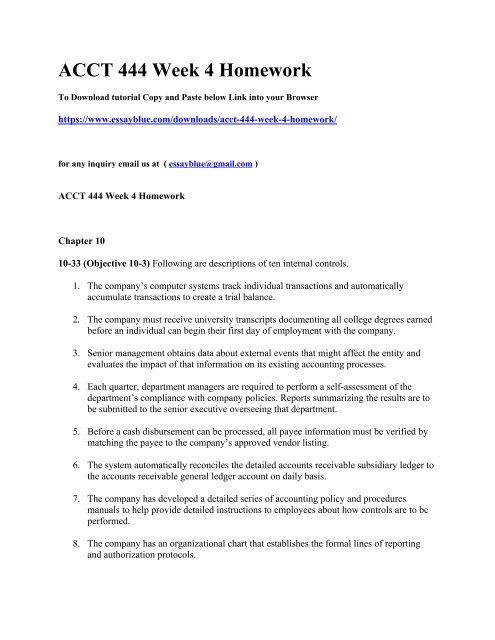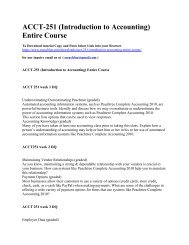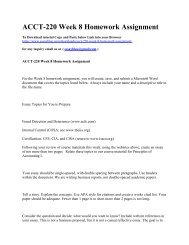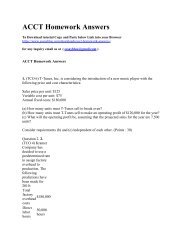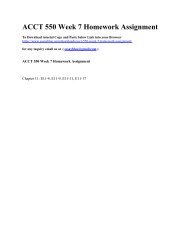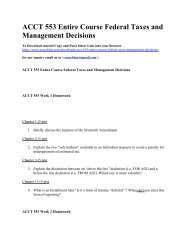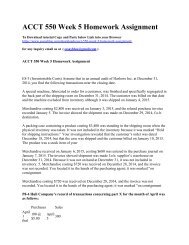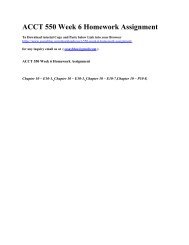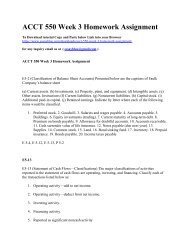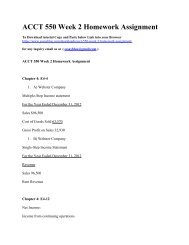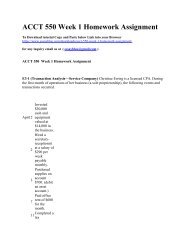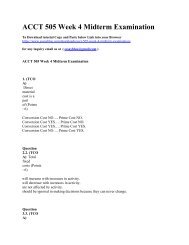ACCT 444 Week 4 Homework
Create successful ePaper yourself
Turn your PDF publications into a flip-book with our unique Google optimized e-Paper software.
<strong>ACCT</strong> <strong>444</strong> <strong>Week</strong> 4 <strong>Homework</strong><br />
To Download tutorial Copy and Paste below Link into your Browser<br />
https://www.essayblue.com/downloads/acct-<strong>444</strong>-week-4-homework/<br />
for any inquiry email us at ( essayblue@gmail.com )<br />
<strong>ACCT</strong> <strong>444</strong> <strong>Week</strong> 4 <strong>Homework</strong><br />
Chapter 10<br />
10-33 (Objective 10-3) Following are descriptions of ten internal controls.<br />
1. The company’s computer systems track individual transactions and automatically<br />
accumulate transactions to create a trial balance.<br />
2. The company must receive university transcripts documenting all college degrees earned<br />
before an individual can begin their first day of employment with the company.<br />
3. Senior management obtains data about external events that might affect the entity and<br />
evaluates the impact of that information on its existing accounting processes.<br />
4. Each quarter, department managers are required to perform a self-assessment of the<br />
department’s compliance with company policies. Reports summarizing the results are to<br />
be submitted to the senior executive overseeing that department.<br />
5. Before a cash disbursement can be processed, all payee information must be verified by<br />
matching the payee to the company’s approved vendor listing.<br />
6. The system automatically reconciles the detailed accounts receivable subsidiary ledger to<br />
the accounts receivable general ledger account on daily basis.<br />
7. The company has developed a detailed series of accounting policy and procedures<br />
manuals to help provide detailed instructions to employees about how controls are to be<br />
performed.<br />
8. The company has an organizational chart that establishes the formal lines of reporting<br />
and authorization protocols.
9. The compensation committee reviews compensation plans for senior executives to<br />
determine if those plans create unintended pressures that might lead to distorted financial<br />
statements.<br />
10. On a monthly basis, department heads review a budget to actual performance report and<br />
investigate unusual differences.<br />
Required<br />
Indicate which of the five COSO internal control components is best represented by each<br />
internal control.<br />
1. Control environment<br />
2. Risk assessment<br />
3. Control activities<br />
4. Information and communication<br />
5. Monitoring<br />
10-41 (Objective 10-7) The following are independent situations for which you will recommend<br />
an appropriate audit report on internal control over financial reporting as required by PCAOB<br />
auditing standards:<br />
1. The auditor identified a material misstatement in the financial statements that was not<br />
detected by management of the company.<br />
2. The auditor was unable to obtain any evidence about the operating effectiveness of<br />
internal control over financial reporting.<br />
3. The auditor determined that a deficiency in internal control exists that will not prevent or<br />
detect a material misstatement in the financial statements.<br />
4. During interim testing, the auditor identified and communicated to management a<br />
significant control deficiency. Management immediately corrected the deficiency and the<br />
auditor was able to sufficiently test the newly-instituted internal control before the end of<br />
the fiscal period.
5. As a result of performing tests of controls, the auditor identified a significant deficiency<br />
in internal control over financial reporting; however, the auditor does not believe that it<br />
represents a material weakness in internal control.<br />
Required<br />
For each situation, state the appropriate audit report from the following alternatives:<br />
<br />
<br />
<br />
Unqualified opinion on internal control over financial reporting<br />
Qualified or disclaimer of opinion on internal control over financial reporting<br />
Adverse opinion on internal control over financial reporting<br />
Chapter 12<br />
12-19 (Objectives 12-2, 12-3) The following are misstatements that can occur in the sales and<br />
collection cycle:<br />
1. A customer number on a sales invoice was transposed and, as a result, charged to the<br />
wrong customer. By the time the error was found, the original customer was no longer in<br />
business.<br />
2. A former computer operator, who is now a programmer, entered information for a<br />
fictitious sales return and ran it through the computer system at night. When the money<br />
came in, he took it and deposited it in his own account.<br />
3. A nonexistent part number was included in the description of goods on a shipping<br />
document. Therefore, no charge was made for those goods.<br />
4. A customer order was filled and shipped to a former customer that had already filed for<br />
bankruptcy.<br />
5. The sales manager approved the price of goods ordered by a customer, but he wrote down<br />
the wrong price.<br />
6. A computer operator picked up a computer-based data file for sales of the wrong week<br />
and processed them through the system a second time.<br />
7. For a sale, a data entry operator erroneously failed to enter the information for the<br />
salesman’s department. As a result, the salesman received no commission for that sale.
8. Several remittance advices were batched together for inputting. The cash receipts clerk<br />
stopped for coffee, set them on a box, and failed to deliver them to the data input<br />
personnel.<br />
Required<br />
1. Identify the transaction-related audit objective(s) to which the misstatement<br />
pertains.<br />
2. Identify one automated control that would have likely prevented each misstatement.<br />
12-26 (Objective 12-4) Following are 10 key internal controls in the payroll cycle for Gilman<br />
Stores, Inc.<br />
Key Controls<br />
1. To input hours worked, payroll accounting personnel input the employee’s Social<br />
Security number. The system does not allow input of hours worked for invalid employee<br />
numbers.
2. The payroll application is programmed so that only human resource personnel are able to<br />
add employee names to the employee master files.<br />
3. Input menus distinguish executive payroll, administrative payroll, and factory payroll.<br />
4. The system automatically computes pay at time and a half once hours worked exceed 80<br />
in a 2-week pay period.<br />
5. The system accumulates totals each pay period of employee checks processed and debits<br />
the payroll expense general ledger account for the total amount.<br />
6. Each pay period, payroll accounting clerks count the number of time cards submitted by<br />
department heads for processing and compare that total with the number of checks<br />
printed by the system to ensure that each time card has a check.<br />
7. For factory personnel, the payroll system matches employee ID numbers with ID<br />
numbers listed on job costing tickets as direct labor per the cost accounting system. The<br />
purpose of the reconciliation is to verify that the amount paid to each employee matches<br />
the amount charged to production during the time period.<br />
8. The system generates a listing by employee name of checks processed. Department heads<br />
review these listings to ensure that each employee actually worked during the pay period.<br />
9. On a test basis, payroll accounting personnel obtain a listing of pay rates and withholding<br />
information for a sample of employees from human resources to recalculate gross and net<br />
pay.<br />
10. The system automatically rejects processing an employee’s pay if inputted hours exceed<br />
160 hours for a 2-week pay period.<br />
Required<br />
For each control:<br />
1. Identify whether the control is an automated application control (AC) or a manual<br />
control done by Gilman employees (MC).<br />
2. Identify the transaction-related audit objective that is affected by the control.<br />
3. Identify which controls, if tested within the last two prior year audits, would not<br />
have to be retested in the current year, assuming there are effective IT general<br />
controls and no changes to the noted control have been made since auditor testing<br />
was completed.


